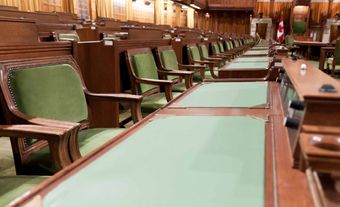Committees
Parliament has many committees which perform functions that cannot be adequately accomplished in debate or question period.
Committee of the Whole (Supply, Ways and Means)
Chaired by the Deputy Speaker, this committee includes all members of the HOUSE OF COMMONS meeting in its normal chamber. Until 1969 the Commons met as a Committee of the Whole to consider legislation clause by clause after second reading of a bill, a task now delegated to the relevant standing committee (see PARLIAMENTARY PROCEDURE).
Estimates were also considered in Committee of Supply and many members would like some estimates to be considered there again, because Committee of the Whole is a public forum attracting great media attention. The Committee of Ways and Means, another version of Committee of the Whole, which dealt with revenue, is now purely symbolic.
Standing Committees
The 25 standing committees are the most important parliamentary committees. Usually chaired by government MPs (except for the Committee on Public Accounts), they have 7-11 members, party representation being proportionate to that in the House of Commons. They include specialist committees, corresponding roughly in concern to government departments, and other committees dealing with matters such as public accounts, miscellaneous estimates and private bills, procedures and organization, privileges and elections.
In Parliament there are also joint standing committees of the House and SENATE. Ministers are not usually standing-committee members, nor, since 1985, are parliamentary secretaries.
Legislative Committees
Legislative committees were created in the reforms of 1985. They are established to examine legislation after it has passed second reading. A different one is created for each bill. The chairmen are selected from a panel, which contains backbench members from each party. They normally have 7 members. Committees exist to consider policy issues, to examine estimates and annual reports, and to scrutinize government legislation after second reading, including supply and ways-and-means legislation. They usually meet only in the capital city and their witnesses are therefore drawn chiefly from groups who can afford to travel or to maintain permanent representatives there.
Many committees, however, make an effort to hold meetings across Canada. The committees choose witnesses and decide which recommendations to submit to the legislature in the form of reports or amendments to bills. If they are reviewing legislation a minister is occasionally the first and last witness, and may review testimony. With supply bills the effectiveness of committees is limited, but the committee can serve as a forum for criticism of government programs and on occasion hold ministers accountable for estimated departmental expenditure.
When the Committee on Public Accounts reviews government accounts and the AUDITOR GENERAL reports on them, this attracts important media attention - far more than when the committee submits its own report to the House.
Special committees (sometimes called select committees), eg, the Special Joint Committee of the Senate and of the House of Commons on the Constitution of Canada, are sometimes established by the House to study specific issues or to investigate public opinion on policy decisions. They are sometimes called task forces but should not be confused with government TASK FORCES.
Both standing and special committees can be joint committees. The Senate also has standing committees, special committees and a committee of the whole. Their investigations on poverty, aging and science have been noteworthy.
Standing committees are too often partisan and government-controlled; they suffer from amateurism because of high turnover in the House, they are inadequately staffed and cannot choose their own topics of study. In recent years they have overcome some of these weaknesses by creating subcommittees with small, stable membership and expert staff. An example has been the Justice Committee's investigation of penitentiaries (1977).
In 1982, as a result of reforms adopted for a trial period, the number of members and the number of membership changes on committees were reduced. Committees were given greater discretion to choose subjects for investigation. Following the report of the Special Committee on Reform of the House of Commons in 1985, the standing committees were given more autonomy and reduced in size. The system of legislative committees was also introduced at this time.
The increased use of committees has not altered the relationship between Parliament and government, which disappoints many critics and private MPs. But Parliament's role is not to govern but to examine, criticize and propose alternatives. On the other hand, committees have strengthened Parliament by increasing its ability to examine and publicize its activities.
Provincial Legislatures
Provincial legislatures have committee systems similar to those of the federal government; but generally, partly because of the small size of the legislatures and greater government domination of the legislatures and the committees, they are less useful or active than their federal counterparts.

 Share on Facebook
Share on Facebook Share on X
Share on X Share by Email
Share by Email Share on Google Classroom
Share on Google Classroom


.jpg)